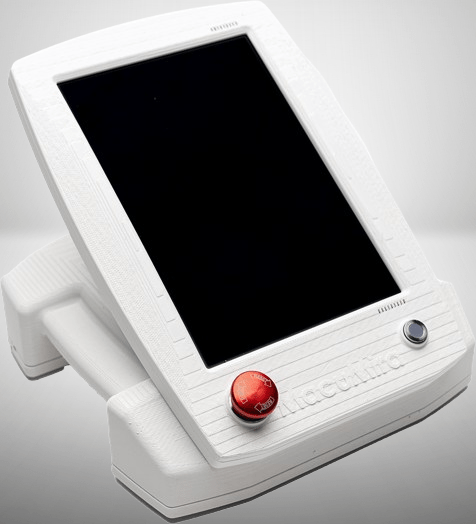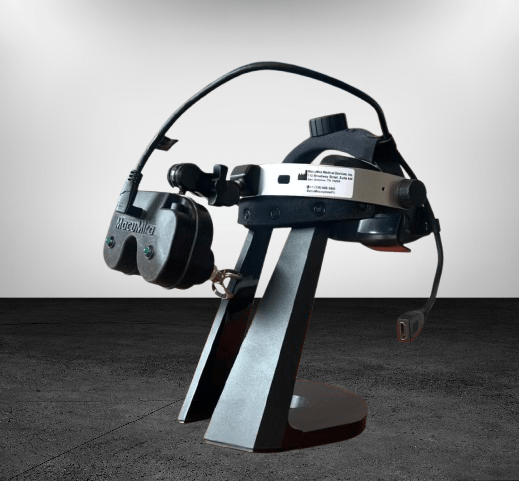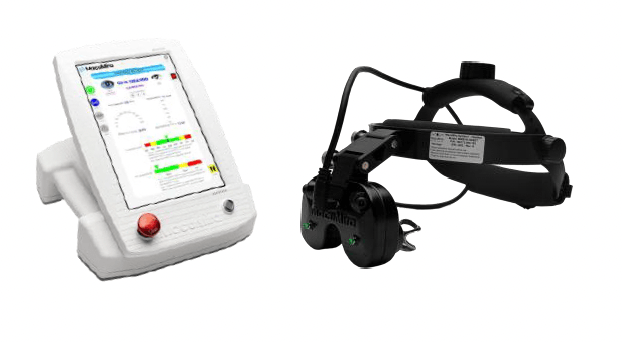MacuMira: Treatment for Dry Age-Related Macular Degeneration
What is MacuMira?
MacuMira is a transpalpebral microcurrent stimulation device designed to improve visual acuity in people with dry AMD. The term “transpalpebral” refers to the application of therapy through the eyelid, a non-invasive method that makes the device convenient and comfortable to use.
What is ARMD?
The device delivers low levels of electrical stimulation to the retina, activating dormant or underperforming retinal cells. This stimulation is believed to enhance cellular activity and promote the health of photoreceptor cells, which are crucial for processing light and maintaining vision.
Age-related macular degeneration (AMD) is a central rential degeneration that effect vision in our central vision, known as Macular which is about 5 millimetre . While there are two types of AMD—wet and dry—the latter is more common, accounting for approximately 85–90% of all cases. Dry AMD develops gradually as the macula, the central part of the retina, thins with age.
This condition can profoundly affect a person’s ability to perform daily tasks such as reading, driving, and recognizing faces, color recognition, distortions,bluriness and blind spots in the central vision.
While dry AMD has no cure, advances in technology, like the MacuMira device, offer hope for improved management.
This blog post explores how MacuMira works, its benefits, and what people with AMD or their caregivers need to know about this innovative approach. and Pegcetacoplan will be discussed in another post.

How Does Microcurrent Stimulation Work?
Microcurrent stimulation is not a new concept in eye care. It has been studied for years as a therapeutic option for various retinal conditions. The principle behind this technology is that tiny electrical impulses can encourage cellular repair and regeneration.
In the context of AMD, microcurrent therapy aims to:
- Stimulate Retinal Cells: The retina’s photoreceptor cells can lose function over time due to oxidative stress and the accumulation of waste deposits called drusen. Electrical stimulation promotes activity in these cells, potentially slowing the progression of the disease.
- Enhance Blood Flow: Poor blood circulation in the retina can exacerbate vision problems. Microcurrent therapy improves blood flow to the eye, ensuring that retinal tissues receive the oxygen and nutrients they need.
- Reduce Inflammation: Chronic inflammation is a significant contributor to the development and progression of AMD. Microcurrent stimulation has been shown to have anti-inflammatory effects, which may help mitigate damage to the retina.
Key Benefits of MacuMira
For individuals living with dry AMD, MacuMira offers several potential benefits. While results may vary depending on the severity of the condition, studies and user feedback suggest the following advantages:
1. Improved Visual Acuity
Many users report noticeable improvements in their ability to see fine details after consistent use of the MacuMira device. Tasks like reading, recognizing faces, and using digital devices become easier as visual acuity improves.

2. Non-Invasive and User-Friendly
One of the most appealing aspects of MacuMira is its non-invasive design. The device is applied externally over the eyelid, eliminating the need for surgeries, injections, or complex procedures. Its user-friendly interface makes it accessible even for individuals who are not tech-savvy.
3. Slows Disease Progression
While MacuMira is not a cure for AMD, it may help slow the progression of the disease. By stimulating retinal cells and improving blood flow, the device addresses some of the underlying causes of vision loss in AMD patients.
4. Customizable Therapy
MacuMira offers personalized treatment options. Healthcare providers can customize the settings to match each person’s unique needs, making the therapy both safe and effective.
Who Can Benefit from MacuMira?
MacuMira is particularly suited for individuals in the early to intermediate stages of dry AMD. It may also be helpful for those who experience mild to moderate vision loss and are looking for ways to preserve their remaining sight.
It’s important to note that not everyone is a candidate for microcurrent therapy. Individuals with certain medical conditions, such as epilepsy, pacemakers, or other implanted electrical devices, should consult with their doctor before using MacuMira.
What to Expect During Treatment
Using MacuMira is a straightforward process that can easily fit into a daily routine. Here’s what users can typically expect:
- Initial Assessment: Before starting therapy, a healthcare provider will conduct a thorough eye examination to determine if MacuMira is suitable for the patient.
- Customized Settings: The device’s settings will be adjusted to provide the optimal level of stimulation based on the user’s specific condition.
- Daily Sessions: Users typically undergo 30 minutes of therapy per eye each day. The device is placed gently over the closed eyelid, and the user may feel a slight tingling sensation during treatment.
- Ongoing Monitoring: Regular follow-ups with an eye care specialist are crucial to track progress and make any necessary adjustments to the therapy plan.
Real-World Results: What Does the Research Say?
Preliminary studies and anecdotal evidence suggest that MacuMira can yield significant improvements in visual function. For example:
- A pilot study published in 2023 evaluated the effects of MacuMira on individuals with dry AMD. Participants experienced measurable improvements in visual acuity and contrast sensitivity after just a few weeks of treatment.
- Another exploratory trial highlighted the potential of transpalpebral microcurrent therapy to enhance retinal function, particularly in patients with early-stage AMD.
These findings indicate that MacuMira could be a valuable addition to the range of management options for AMD, particularly for those seeking non-invasive solutions.
Tips for caregivers of AMD Patients
Caring for someone with AMD can be challenging, especially as the disease progresses. Here are some tips to support a loved one undergoing MacuMira therapy:
- Encourage Consistency: Like any therapy, the benefits of MacuMira are most apparent with regular use. Help your loved one incorporate daily sessions into their routine.
- Monitor Progress: Keep track of changes in vision and overall eye health. Share these observations with the healthcare provider during follow-up appointments.
- Create a Supportive Environment: Make the home environment more accessible by improving lighting, using magnification tools, and reducing clutter.
- Educate Yourself: Learn about AMD and available treatment options so you can provide informed support. Resources like this blog can help you stay up to date on the latest advancements.
FAQs About MacuMira
Q: Is MacuMira safe?
Yes, MacuMira is designed to be safe for most users. However, individuals with specific medical conditions should consult their doctor before use.
Q: Can MacuMira cure AMD?
No, MacuMira is not a cure for AMD. It is a management tool that can help improve visual function including Contrast Sensitivity and Visual Acuity, and slow the progression of the disease.
Q: How soon can I expect results?
Results vary, but many users report improvements within a few weeks of consistent use.
Q: Do I need a prescription to use MacuMira?
Yes, MacuMira should be used under the guidance of an eye care professional to ensure optimal results and safety.
Conclusion
Living with dry AMD can be challenging, but advancements like the MacuMira device offer new opportunities for improved vision and quality of life. By stimulating retinal cells, enhancing blood flow, and reducing inflammation, this innovative technology provides a non-invasive, user-friendly option for managing the condition.
If you or a loved one has AMD, consider discussing MacuMira with an eye care specialist to determine if it’s the right fit. With proper guidance and consistent use, this device could be a valuable tool in preserving vision and maintaining independence.
Remember, managing AMD is a journey, and tools like MacuMira can make that journey a little clearer—literally and figuratively.






